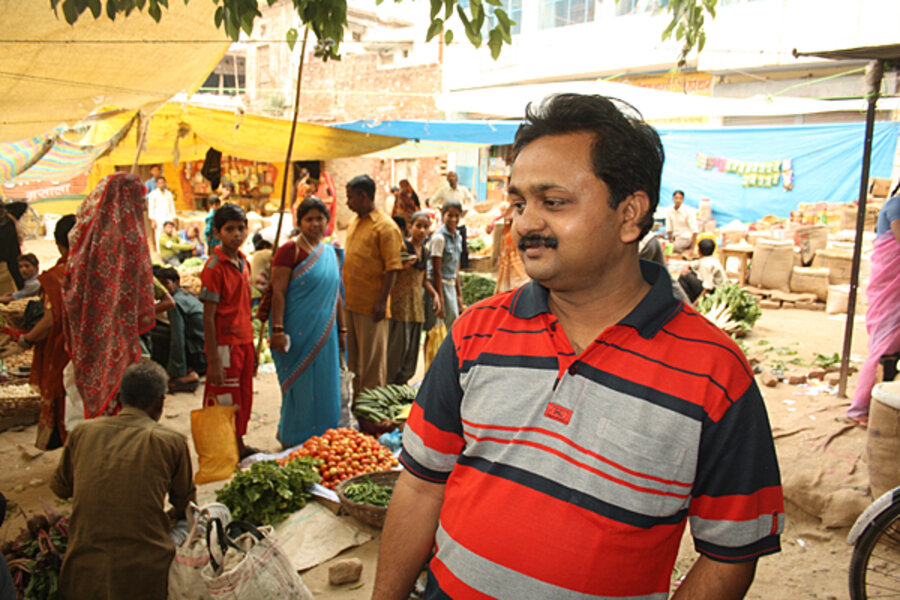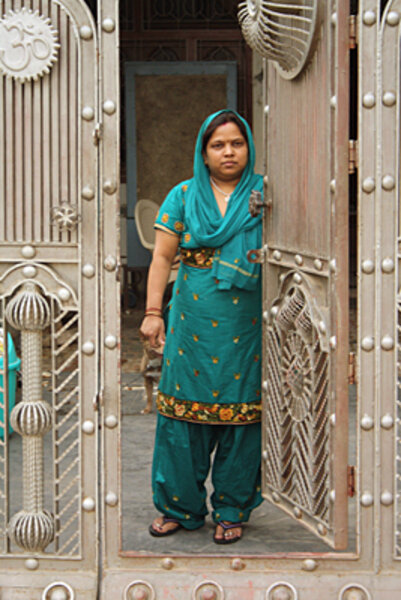For Indians, the climb into the middle class is a family affair
| Fatehgarh, India
By Indian standards, Aditya Kumar has made it. He has a secure government job and his mother, wife, and two kids live in one of the largest homes in this village.
What he – and many in the Indian middle class – don't have is much autonomy. Mr. Kumar dreams of being an entrepreneur living in a big city. Instead, he's stuck halfway.
During the week, he lives and works as a youth development officer in Agra, the nearest city. On weekends, he takes a four-hour bus ride back here to his family.
With his mother's pension, Kumar's family has purchased three taxis. He wants to scale up this side business and quit his job. But such decisions in India aren't left to one person. "I do not have the ability to choose the business I want to because [my mother] won't approve," says Kumar, who is 38. As for moving, "she said 'I will never leave this home.' I did not find it right to leave my mother alone."
His wife, Babita, also wants him to stay in his "respectable" job. She, meanwhile, wanted to work as a teacher, but her husband convinced her to take care of the home because he and his mother already work.
"A lot of these choices become more family choices than individual choices," explains Sonalde Desai, a sociologist with the National Council of Applied Economic Research in Delhi. But it would be incorrect to say that economic growth isn't expanding freedom, she says. "It's a freedom that you can transcend the circumstances that you came from, that your children can transcend those circumstances – transcend as a family."
Kumar's mother, Reshmi Devi, prays cross-legged before Hindu gods arranged in a shrine she had built in a quiet, upstairs nook of the house. At age 63, she has achieved serenity unimaginable even two decades earlier, when she lived on this same land in a one-room mud hut with a dirt floor.
The matriarch hauled her family into the middle class through education, even though she was removed from school after Grade 5 and sent to live with her husband at age 13. At that tender age, she realized that her new husband was a struggling carpenter who couldn't support a family.
"I went up to him and asked, 'How can we supplement it?' There was no other thing I could think of than getting educated," says Mrs. Devi. Her father-in-law forbade it. Women weren't supposed to leave the home. But at 18, with her husband's permission, she returned to the classroom alongside girls as young as 8.
Five years later, Devi had enough education to qualify for a well-paid government job as a nurse in a hospital. Her husband, "a good man," she says, braved village derision and agreed to be Mr. Mom to their kids.
A framed photo of Devi's late husband hangs close to the living-room ceiling, centered above the TV and the framed honor roll certificates of her grandchildren.
Devi's sole purpose for the money she earned was educating her three children well. She then turned to building a proper house because "I had to get my kids married off. Where will my daughter-in-law stay? Where will my son's children live?"
She stayed put in this rural region where migrant workers returning by train pull the emergency chain and jump into the wheat fields to save a long trip from distant stations.
Devi's house has two stories, marble floors, and four bedrooms. She sleeps in one. The rest of the family – the Kumars and their 10-year-old, Lavanya, and 6-year-old Aryan – share a big bed in another. A third is a fully furnished guest room.
The fourth bedroom, Kumar is finishing for the two kids to share. "I think they feel more secure sleeping with their mother, but this will certainly make them more independent," she says.
A child having her own bedroom is new to India, says Christiane Brosius, author of "India's Middle Class: New Forms of Urban Leisure, Consumption and Prosperity." Withdrawing to your own room, playing your own music, having your own friends over, and that you "want to be with them," says Ms. Brosius, is new: "That belongs to a kind of privacy that distinguishes you from your parents."
Kumar's salary, Devi's pensions, and taxi proceeds bring in the equivalent of $17,670 a year.
Kumar's family income puts them within the top 10 percent of all Indian homes. The consulting firm McKinsey & Company classifies those making $7,200 to $18,000 as "seekers," the bottom level of the Indian middle class. As of 2010, the seeker income bracket made up only 14 percent of the Indian population, and two higher brackets just 3.5 percent. Seekers, however, may be the Indian middle class of the future: McKinsey projects growth in this bracket, to one-third of India's population by 2025.
It's hard to define middle-class, says Ireena Vittal, a McKinsey partner. "The question becomes middle-class for what? We're trying to understand a classification of the Indian economy from a consumption point of view."
Ms. Desai and others argue that aspirations more than income define the middle class. So she includes people much poorer, she says, recalling giving a talk in the United States that included a slide of how many "middle class" Indians didn't have flush toilets. "The moment I presented that toilet statistic, people just shut off," she laughs. "I suspect we will have to come up with a more indigenous definition because the family buying a Toyota Corolla is wealthy.... A middle class can't be 5 percent of society."
Kumar's family does own a car, but a low-end Maruti Swift. They also have an older IBM ThinkPad laptop, an Internet connection, and cable TV.
Mrs. Kumar quickly gave up learning to drive: Many vendors bring goods to their home, so she only goes out with a driver for monthly shopping trips or school meetings. She has more education than anyone in the house, but the least mobility.
The middle class is more "retrogressive" on women's freedom than lower classes, says Desai: "One of the most striking things about India is that [the] female employment rate falls with more education and income."
Families can afford the social status of not having women working or even going out much. Yet the middle class is pushing to educate daughters like never before.
Everyone in the Kumar family wants Lavanya to be highly educated – and they envision greater freedoms for her, including choosing her husband. Mrs. Kumar, in particular, wants her to drive, get a good job, and "be dependent on ... nobody else."






